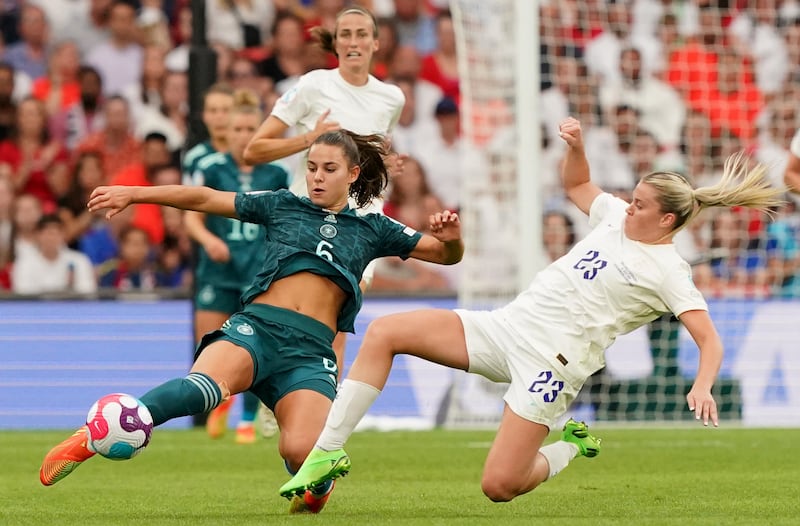The higher standard of player that you encounter, the different questions they ask of you. The different playing styles presented by teams from other parts of the world helps develop the decisions that a player makes and forces them to find new solutions.
This week I write from San Jose, the capital of Costa Rica, where the Fifa Under-20 Women’s World Cup kicked off on Wednesday.
Costa Rica is where the next Chloe Kelly or Lena Oberdorf will be discovered. It’s where they begin to shine on a global stage.
I’m here with Fifa’s technical team to observe and analyse the trends that emerge from the tournament, so we can help develop the game at this level globally and gain further insights into the player pathway from under 17, under-20 and on to the senior ranks.
If hurling is so good, why is it so small?
Meath scored more in one half against Dublin than entirety of previous nine meetings
Ricardo De Burgos Bengoetxea’s crazy minute shows how hard it is to referee El Clásico
Fin Smith meets Sam Prendergast in latest test of young outhalves under constant scrutiny
It’s the first time the biennial competition is being played since 2018 due to the pandemic and after a sensational women’s European Championships last month in England, it will be brilliant to see what the standard is across the best under-20 teams from around the world.
This age grade is a vitally important stepping stone in a player’s development as they attempt to bridge the gap to senior football. You only have to look at the Euros to see the number of players that featured at that last instalment in France.
England’s winning squad had five players who played in the 2018 tournament. Lauren Hemp and Georgia Stanway started every game last month while Alessia Russo had an incredible goal return off the bench, and Chloe Kelly scored the winner at Wembley.
The fifth member of that under-20 team to graduate to the England senior squad is goalkeeper Ellie Roebuck, who many saw as unlucky not to feature at Euro 2022, owing to the fact she has been outstanding as Manchester City goalkeeper. When injured, she lost out to Manchester United’s Mary Earps, and could not get the starting berth back.

When you look at beaten finalists Germany, they also had five players in their Euro 2022 squad that played in the 2018 Under-20 World Cup, including Oberdorf who was named Young Player of the Tournament last month. Guilia Gwinn and Klara Buhl also progressed from that German under-20 team and were both named in Uefa’s 2022 Team of the Tournament.
Looking at other teams, the trend is similar. Spain had six players from the 2018 tournament (including Patricia Guijarro and Aitana Bonmati), France had four, including star striker Marie-Antoinette Katoto, who unfortunately suffered an ACL injury which cut short her 2022 tournament.
There is real merit in qualifying for these underage tournaments because the experience the players gain at them cannot be underestimated. Former Germany international Anja Mittag is also part of our team and it’s been so interesting to get her insights into how much of a difference getting to, and winning, an Under-20 World Cup had on her own development.
Mittag has done it all. She won a senior women’s World Cup in 2007, won three European Championships, an Olympic gold medal and had the record of being top all-time goalscorer in the women’s Champions League, and 50 goals in 158 senior internationals reinforces how important it is to feature at underage international tournaments, and how much better it can make you as a player.
It’s the different experiences players will encounter in Costa Rica that stretch the thinking process and the execution of players. Also, the whole experience of being away from their normal surroundings for extended periods of time can challenge the whole team environment.
Experiencing all of that, in different cultures, with language barriers and weather conditions that teams may not be used to, also stretches the players individually and the group as a whole.
The technical, tactical, physical and mental opportunities for growth are genuinely significant and give players, who get to experience it, an advantage in their individual development.
Even when you think of it, the influence of a trip abroad to play against a team from another country has a big impact on a young kid and can often be one of the standout memories they collect from their time playing football.
The modern game asks more of its top players now. They must be good at all facets of the game, both in and out of possession, so getting young players to big tournaments will have a huge impact on the development of those players and of their senior national teams in both the men’s and women’s football. So really investing in qualifying for these tournaments can yield big returns.
I find it fascinating to track the trajectory of the players that we see in the games over the next three weeks and how many of them make the progression to future senior World Cups.
















